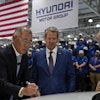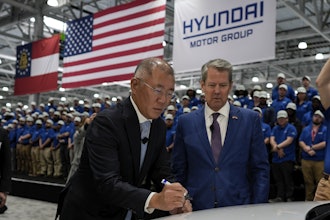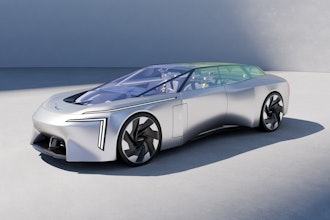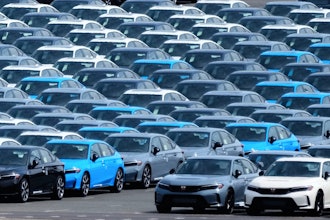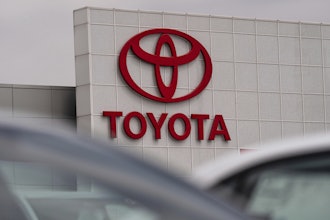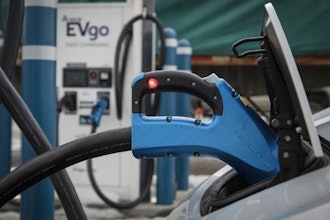NEW YORK (AP) -- Music blared and lights blinked as the pint-sized car descended from the ceiling. A platform lowered it to the ground and photographers rushed to snap pictures.
This was how Toyota showed off its latest, tiniest car -- the iQ -- at the New York International Auto Show. The message from the Japanese automaker was clear: This is the car of tomorrow.
But is it?
Small cars and hybrids surged in popularity last summer as gasoline prices blew past $4 a gallon. Compacts and subcompacts -- including cars like the Toyota Yaris and Ford Focus -- surged to more than a quarter of new vehicle sales in June and July, according to data from auto Web site Edmunds.com.
But as the economy sputtered and gas prices collapsed, small cars lost ground to trucks and sport utility vehicles. Compacts and subcompacts last month commanded about 20 percent of the new car market, according to Edmunds.
"I heard it the other day -- I don't know if it's true -- that Americans' memory is about 60 days," said Tim Mahoney, senior vice president of Subaru of America. "You can see the fuel-economy situation from last summer. I heard (a dealer) the other day talking about how they couldn't sell Civics and Corolla and Priuses fast enough. All of a sudden, 60 days later, we're back on SUVs and trucks."
Small cars still took center stage at the New York auto show, which opens to the public on Friday after two days of media previews. Automakers unveiled their fair share of sedans and crossovers, but much of the attention was on cars like the iQ, the Fiat 500 and the Volkswagen Golf VI, which won the show's top award.
"It is the time for small cars," said Stefan Jacoby, chief executive Volkswagen of America. "We will see a certain trend toward small, compact cars in the United States."
One of Toyota Motor Corp.'s main attractions is the iQ, a tiny model that has room for three adults and is already on sale in Europe and Japan. At 10 feet, 7 inches (3.2 meters) bumper-to-bumper, the iQ is only about 2 feet (0.6 meters) longer than the Smart fortwo.
Toyota, which is displaying the car with a Scion badge in New York, is still weighing a release date for the U.S.
The Golf VI took the show's World Car of the Year award. The car is on sale only in Europe, but it is similar to the Volkswagen Rabbit compact car in the U.S. Its competition for the prize? The Ford Fiesta small car and the iQ.
Perhaps the little car making the biggest splash was the Fiat 500. On Wednesday, Chrysler LLC President Jim Press surprised reporters when he drove the iconic minicar onstage during the automaker's press conference to unveil a new Jeep Grand Cherokee. Chrysler, faulted for focusing too much on trucks and SUVs, is likely to bring the 500 to America if it completes a deal with Italian automaker Fiat SpA and survives its financial troubles.
But with compacts and subcompacts losing market share again, the automakers' excitement may not match that of car buyers.
"It's completely overblown," said John Wolkonowicz, senior automotive analyst with the consulting firm IHS-Global Insight. "Right now, there is no movement to smaller cars. The movement to smaller cars happened last summer, when the price of gas rapidly shot up to $4 a gallon. As soon as gas fell down again the move to small cars withered."
Subaru's Mahoney said Americans deep down don't want small cars. But they do want fuel economy. So instead of focusing on whether a car is big or small, automakers should try to find ways to boost gas mileage without sacrificing size or comfort.
Subaru unveiled two new vehicles Thursday: a new Legacy sedan and Outback crossover. Both vehicles are larger than their predecessors, but revamped engines boost their fuel economy.
"If you don't have to trade anything off, why would you?" Mahoney said in an interview.
Chrysler is hoping to take a similar approach. Rather than drop its large-car segments -- which deliver higher profit margins than small cars, anyway -- it plans to offer electric motors in the vehicles it already has through technology being developed by its high-tech ENVI unit.
The company has already shown off five different electric-drive vehicles and plans to start selling one of them next year.
"Our approach really is to make the powertrain -- the electric motor, the battery, the controller -- more of a module. It can move from vehicle to vehicle," said Frank Klegon, Chrysler's product development chief.
For some consumers, like Karen Hirshfield, a small car simply won't work. Hirshfield, 36, a lawyer from Woodcliff Lake, New Jersey, bought a Buick Enclave two months ago because it had a minivan's space without the soccer-mom stigma. She said she also would like a car with good fuel economy, but that is secondary to space.
"Anyone who lives in the suburbs with kids will tell you that you would never look at a small car because you can't put your kids in it, you can't put your kids' friends in it," said Hirshfield, who has two kids, ages 3 and 5.
General Motors Corp. unveiled the 2009 Enclave last year. Its fuel economy isn't spectacular: a combined EPA-rated 19 mpg. But for Hirshfield, it's a good fit.
"I think this time GM has a winner, if they survive," she said.


